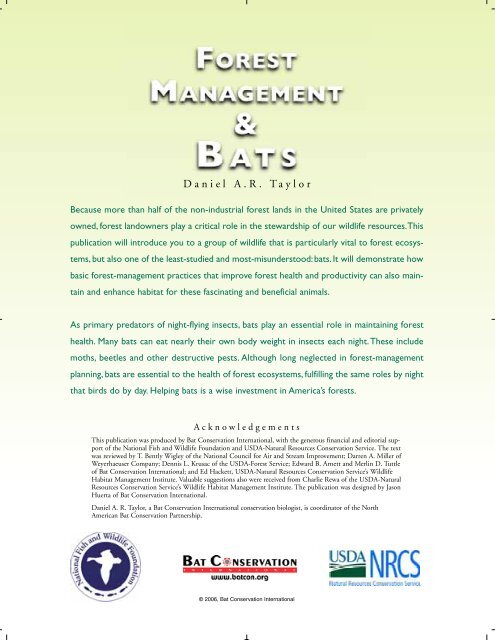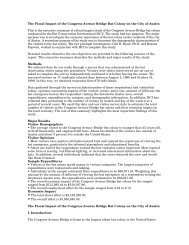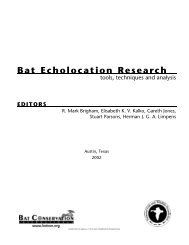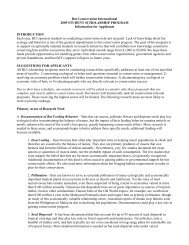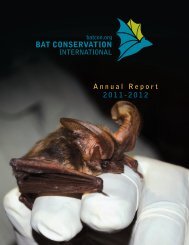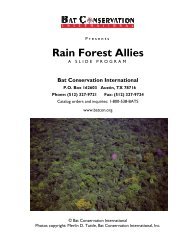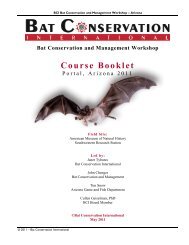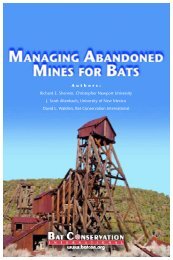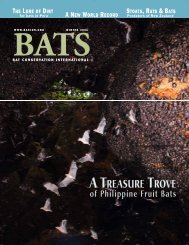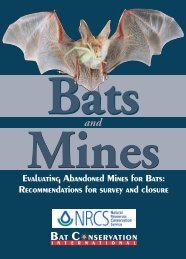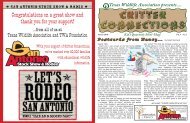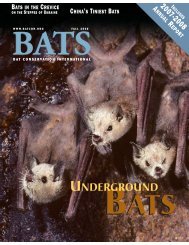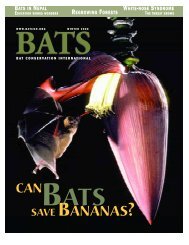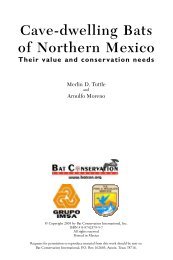Forest Management & Bats - Bat Conservation International
Forest Management & Bats - Bat Conservation International
Forest Management & Bats - Bat Conservation International
Create successful ePaper yourself
Turn your PDF publications into a flip-book with our unique Google optimized e-Paper software.
D a n i e l<br />
A . R . T a y l o r<br />
Because more than half of the non-industrial forest lands in the United States are privately<br />
owned, forest landowners play a critical role in the stewardship of our wildlife resources.This<br />
publication will introduce you to a group of wildlife that is particularly vital to forest ecosystems,<br />
but also one of the least-studied and most-misunderstood:bats. It will demonstrate how<br />
basic forest-management practices that improve forest health and productivity can also maintain<br />
and enhance habitat for these fascinating and beneficial animals.<br />
As primary predators of night-flying insects, bats play an essential role in maintaining forest<br />
health. Many bats can eat nearly their own body weight in insects each night.These include<br />
moths, beetles and other destructive pests. Although long neglected in forest-management<br />
planning, bats are essential to the health of forest ecosystems, fulfilling the same roles by night<br />
that birds do by day. Helping bats is a wise investment in America’s forests.<br />
A c k n o w l e d g e m e n t s<br />
This publication was produced by <strong>Bat</strong> <strong>Conservation</strong> <strong>International</strong>, with the generous financial and editorial support<br />
of the National Fish and Wildlife Foundation and USDA-Natural Resources <strong>Conservation</strong> Service. The text<br />
was reviewed by T. Bently Wigley of the National Council for Air and Stream Improvement; Darren A. Miller of<br />
Weyerhaeuser Company; Dennis L. Krusac of the USDA-<strong>Forest</strong> Service; Edward B. Arnett and Merlin D. Tuttle<br />
of <strong>Bat</strong> <strong>Conservation</strong> <strong>International</strong>; and Ed Hackett, USDA-Natural Resources <strong>Conservation</strong> Service’s Wildlife<br />
Habitat <strong>Management</strong> Institute. Valuable suggestions also were received from Charlie Rewa of the USDA-Natural<br />
Resources <strong>Conservation</strong> Service’s Wildlife Habitat <strong>Management</strong> Institute. The publication was designed by Jason<br />
Huerta of <strong>Bat</strong> <strong>Conservation</strong> <strong>International</strong>.<br />
Daniel A. R. Taylor, a <strong>Bat</strong> <strong>Conservation</strong> <strong>International</strong> conservation biologist, is coordinator of the North<br />
American <strong>Bat</strong> <strong>Conservation</strong> Partnership.<br />
© 2006, <strong>Bat</strong> <strong>Conservation</strong> <strong>International</strong>


